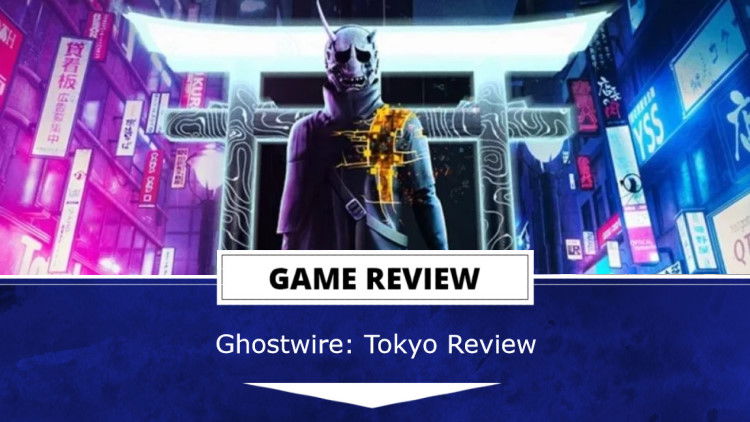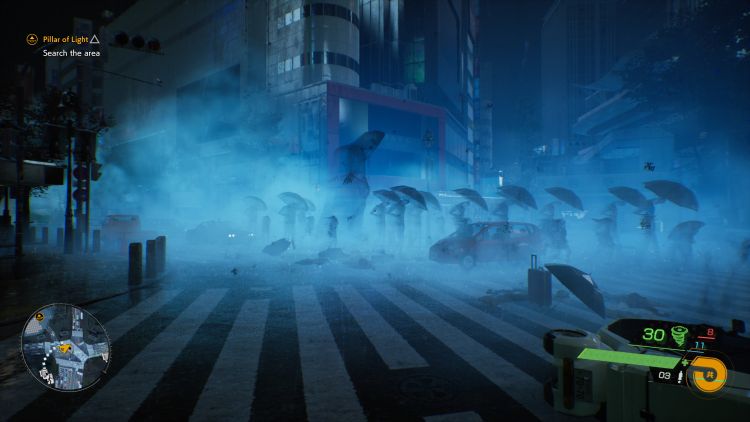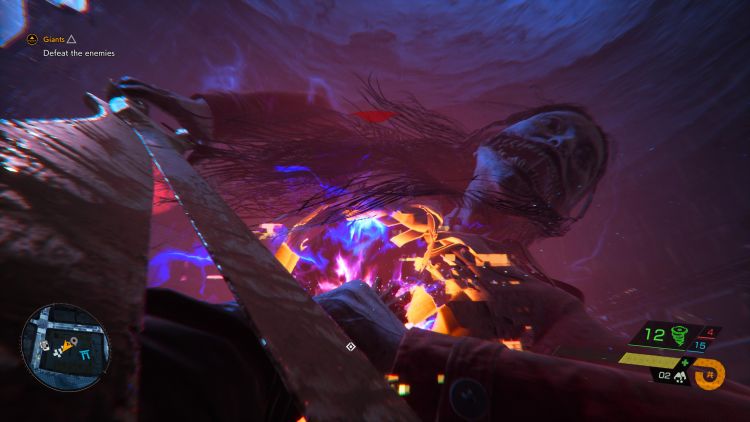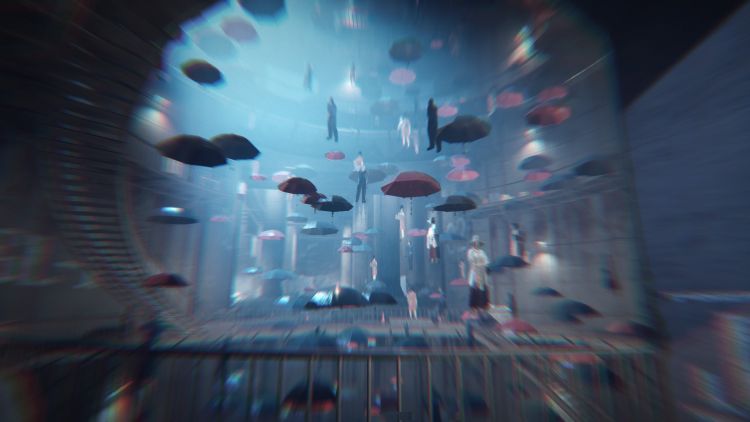If you read our hands-on preview of Tango Gameworks and Bethesda’s latest game, Ghostwire: Tokyo then you’ll know I held back in talking about a lot of the game. Well, the review embargo is over and now I’m allowed to really talk about how cool the game is.
Developer: Tango Gameworks
Publisher: Bethesda Studios
Platforms: PC, PS5
Release Date: March 25th, 2021
Where we Last Left Off:
Ghostwire: Tokyo is set in, you guessed it, the modern-day city of Tokyo. Things begin high above the city as a disembodied voice searches from the skies looking for a body to inhabit. Unable to possess the body of a living human that’s where our hero Akito comes in. Akito, it seems, is unfortunately on death’s door leaving the perfect opportunity for the spirit to take over. In doing so, Akito wakes and a thick fog envelops the city, consuming any human caught within. To make matters worse, ghostly “Visitors”, creatures formed from negative emotions and brought to life by ether, follow in the fog’s wake.
The spirit introduces himself as KK and Akito rushes to a nearby hospital, in hopes of saving his sister. Upon arriving at her room, however, she’s in the process of being abducted by a mysterious man in a Hannya mask. Akito attempts to intervene but is once again killed in the process, however, due to KK taking residence in his body, he offers Akito another chance at life so long as he helps KK get to the root of the problem. Akito agrees and the two set out to save his sister Mari and stop the man in the Hannya mask.
I feel it’s important to state right now that I did not beat the game as of writing this review. When I had the time to play the game, I spent far too much time exploring Tokyo and partaking in the game’s side content. Although, I can say that what I have experienced so far has been quite enjoyable and I rather like the relationship forming between Akito and KK as well the mystery of the fog consuming Tokyo. In saying this, this review will focus solely on gameplay and performance until I can finally finish the story. Check back in the future as once I do, I’ll make sure to update this section.
A Man About Town:
Never have been as enthralled by an open-world game as I have been with Ghostwire: Tokyo. Tokyo is a city made up of skyscrapers, compact streets, neon lights, and exploring it is incredibly fun. Despite the city’s empty streets, there’s a lot to do in the form of spirits to rescue, yokai to find, and relics to collect. One of my favorite events is the Hyakki Yako parades. They appear out of nowhere and aren’t related to a sidequest. An eerie fog rolls down the street as the Visitors march down the road. If you’re spotted, you get sucked in and have to battle waves of Visitors to escape. It’s fun and a good way to earn some experience.
Then, there are side quests that explore the more mystical and occult side of Japanese folklore. Like a train in a subway that appears if you’re the only one boarding or a cursed doll that disappears. It’s up to KK and Akito to investigate these issues and help the spirits tethered to this world move on. One of my favorite quests is one we actually recorded and featured the house of a hoarder. In the afterlife, his home became a black hole that consumed the spirits around it. We had to go into the house and break the curse on the house. It was a quick quest but easily one of my favorites.
The game really does its best to get you out and about. Akito can level up and earn skill points to unlock new abilities. A good portion of the abilities are gated and require Magatama (experience points) to unlock, which are earned by finding one of the game’s many yokai scattered around the city. Beaded bracelets provide various stat bonuses and can be collected at cleansed Torii gates. Players can increase their elemental SP pool by hunting down the fifty-plus Jizo statues or earn more skill points by finding KK’s missing investigation files. Shops run by yokai are also a great way to stock up on healing supplies and refill your arrows. I can’t stress enough how rewarding exploration can be in Ghostwire.
Getting around the city is pretty simple and easy to do. Akito can clamber up ledges and with KKs power, glide around the city. Flying Yokai that scattered across the rooftops, allowing Akito to grapple onto them and provide the fastest to get to a rooftop. The movement system is a tad clunky though. I’ve experienced far too many moments where Akito’s position didn’t mesh with the jump button and he doesn’t always clamber up over ledges like you think he will. That didn’t stop me from spending a majority of my time climbing up buildings and gliding around like some kind of occult Batman.
My biggest complaint about exploration in the game would be that it’s gated. The fog blanketing Tokyo can kill you if you step into it and is only pushed back when cleansing nearby Torii gates. You only have access to so many Torii gates at a time but by chapter 4, it feels like you can get to most of them. On one hand, I do think it’s a fun way to spice up the “tower” mechanic open-world games used to include but on the other, it does make progression feel gated, especially when you know something is just out of reach.
Blast ‘Em:
Taking place from a first-person perspective, Ghostwire: Tokyo plays like a first-person shooter. Instead of giving players a gun, Akito uses a form of combat known as “Ethereal Weaving”. It allows him to harness the elements of wind, fire, and water to combat the invading Visitors. Personally, I find weaving to be a fun, stylish, and unique way to deliver a first-person action game. Wind is your basic and most useful skill. It has a lot of SP and can be upgraded for increased speeds. Water and fire are more situational and honestly, a lot more fun. Your elements can be charged for powerful attacks. Fire can be charged to explode on contact and water is great for taking on multiple foes while up close with its wide, sweeping attacks.
One of the most satisfying portions of the game’s combat is the core system. By damaging enemies, you can expose a Visitor’s core. Once exposed, Akito can grab it and shatter it, killing the Visitor. Skill upgrades can make this process faster and using his weaving abilities, Akito can grab multiple cores at a time. There is another ability you unlock at the end of chapter 2 that will damage all Visitors nearby and give Akito a temporary stat boost as well, making it easier to expose cores.
As I said above, Weaving runs on “SP” and it’s basically your element’s ammo. When you run out of SP, you can no longer use that form. Thankfully, the game is generous in how it provides you with ammo. The streets are littered with objects corrupted by ether and shattering them refills your SP. Some ether can also explode, dealing heavy damage to any Visitor near it and when Visitors are defeated, they also drop SP. The game never leaves you feeling starved and desperate for ammo. Well, that’s not entirely true.
Akito is, on occasion, separated from KK and you’re cut off from your ability to weave and leaving him nearly defenseless. Thankfully, he also has access to a bow, talismans and of course, stealth is an option as well. It’s hard to describe how I feel about these moments because I’ve only experienced them twice. The first time was my least favorite because I had to escape an underground tunnel and find KK. The other time it happened during a boss battle, which was a great way to handle the fight. I wasn’t just throwing wind and explosive spears at it but had to rely on stealth to avoid the boss and sneak up on it from behind and free my friend. So, I guess I’ll just say that these moments are hit or miss moments within the game. They stink when you’re alone in Tokyo without access to KK’s power but work great when applied to the right set pieces.
Bringing the City to Life:
What makes Tokyo so fun to explore is how alive it ends up feeling. There are a lot of little details that went into crafting the world around the players. The sudden disappearance of almost every human being didn’t halt its nightlife atmosphere. Walk too close to a restaurant and you’ll hear the music booming inside. Clothing and abandoned cars litter the streets. One excellent detail I’d like to point out is how battling Visitors affects the world. If you’re spotted, lights will dim and turn red. Once all the visitors are defeated, things go back to normal.
The Utena spaces are another nice touch as well. These spaces are areas of the game where reality has become distorted by underworld influences. Rooms will flip on their side, images will shift and move. There’s a space in chapter 3 that was easily one of my favorites and it reminded me of the “Ashtray Maze” from Control. We had to rescue one of KKs friends and as we chased after her, the space would shift. Moving around me to prevent me from saving them. It was a great moment and led up to an awesome boss encounter.
The ethereal weaving is just a cool-looking form of combat as well. The neon aesthetic it provides adds a layer of color to the game’s otherwise bleak atmosphere. Visitors show visual damage as their cores are exposed and shattering them will bathe the area in a neon glow. I do wish the Visitors themselves had more variety. There are some genuinely creepy enemies in the game but eventually, new enemies just become tougher versions of old Visitors with a color palette swap.
Tango took full advantage of the Dualsense for Ghostwire: Tokyo as well. It does all the fun things you expect it to do like vibrating along with the falling rain, and the adaptive triggers offer resistance as you shatter cores or cleanse Torii gates. I like that KK speaks through the controller’s speaker and when you’re close to Visitors, an eerie screeching emanates from the controller as well. If you ping a nearby collectible, the haptic feedback will also do its best to point you in the right direction as well. My favorite thing to do is using the Dualsense’s touchpad to cast hand seals.
Performance was a problem for me. Running the game in quality mode on PS5 is a bad idea. The frame rate just couldn’t keep up and I experienced a lot of screen tearing. That said, the game does offer 6 graphical options and I ended up using the High Frame Rate Performance mode, where the game ran very well.
In Conclusion:
Other than performance hiccups, my issues with the game are very small. I didn’t love being separated from KK, there’s a lack of variety in the Visitors and the movement feels clunky. Aside from those things, I am having a wonderful time with the game. While I haven’t gotten to the end of the story yet, big things have happened and I’m hoping we can get a sequel. I truly appreciate the spin Tango Gameworks tried to put on the open-world genre.
It should be a testament to Tango Gameworks’ dedication to world-building that Tokyo and the side content contained within it is able to potentially pull you away from the main story as it did me. Whenever I would try to get back on track, I’d see a group of lost spirits on a rooftop, or I’d go out of my way to hunt down a mythical creature wandering about the city streets. I consistently found myself getting lost in alleyways or the skyline as the game kept pulling me deeper down the rabbit hole.
Ghostwire: Tokyo
Ghostwire: Tokyo Review
Despite its performance issues and clunky movement system, Ghostwire: Tokyo offers a unique twist on the First-Person, Open World formula. Ethereal Weaving is a fun way to combat the creepy visitors and it’s incredibly easy to get lost in the Tokyo’s dark alleyways.
Pros
- Ethereal Weaving is great.
- Tokyo is easy to fun to explore.
- Side content is great.
- Makes full use of the Dualsense’s features.
- Little details make the city feel “alive”.
Cons
- Performance issues.
- Exploration IS gated.
- Clunky movement.
-
Ghostwire: Tokyo







